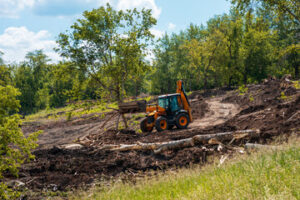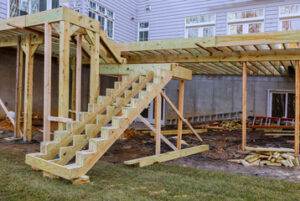Land Clearing is a crucial step in the preparation of land for agricultural purposes. The process involves removing trees, shrubs, and underbrush to cultivate healthy soil with the right levels of nutrients.

Efficient clearing requires a thorough evaluation of the terrain and a careful choice of equipment. Using specialized machinery makes the process much faster, and it reduces waste and environmental impact.
Overgrown areas of vegetation are the perfect breeding grounds for pests. Disease-carrying mosquitos, wood-destroying insects, and rodents find their home in dense brush and can easily spread to the rest of your property. Dense bushes also attract snakes and other wild animals. Performing land clearing helps eliminate the pests and prevent them from infesting your yard or any future structures that you may build on the land.
In addition to preventing pests, land clearing helps keep your property safe from fire. A build-up of leaves, dry twigs, and other debris is a fire hazard, while dead trees can fall onto people or buildings during storms or strong winds. In addition, rotting trees harbor airborne viruses that can spread to nearby plants and cause them to die.
By removing the overgrown vegetation, land clearing makes it easier to spot signs of pest activity such as burrows or nests, making it easier to take action. It also helps to reduce the risk of pests getting too close to your house, which can be a health hazard and make it hard to enjoy the outdoors.
Another benefit of land clearing is that it improves the overall look of a property, making it more attractive and appealing to potential buyers. This can increase the value of a property and help you sell it faster. Land Clearing also includes removing invasive species, which are plants, insects, or animals that don’t belong in an area and can wreak havoc on the ecosystems they invade.
Using mechanical and controlled burns, land clearing professionals can remove unwanted vegetation and clear land that is unusable or overgrown. This can be especially important if you plan to build on the property in the future. Clearing the land allows for a clean slate that can be built upon to meet your specific needs. In addition, clearing the land can prevent erosion and make it safer to use.
It Makes the Land More Useful
Land clearing is not only an important part of the land preparation process, but it also makes the property more useful for a variety of purposes. This includes allowing the planting of crops, commercial development, and improving the overall aesthetics of the property. In addition, it can prevent fire hazards and help maintain healthy soil.
Overgrown lots quickly become dominated by different types of foliage, making it difficult for other plants to grow or receive sunlight. This can also cause the soil to become depleted of nutrients. Clearing the land allows the soil to become more fertile, which is vital for crop growth and a healthy ecosystem.
In addition, rotting trees and bushes can harbor dangerous diseases that can be spread to other parts of the property or neighboring areas. The removal of these dangers through land clearing ensures that the property is free from potential pests and disease. It is also an excellent way to improve the appearance of a property and increase its value.
Commercial developers are attracted to properties that are well maintained and clear of weeds, debris, and other overgrowth. This is one of the most significant reasons why people choose to use land clearing services. Similarly, clear land is alluring to buyers looking for a place to build homes or other structures.
Before starting any project, it is essential to obtain the necessary permits. This will ensure that the land clearing process complies with environmental standards and regulations. It will also protect endangered species and other habitats that may be affected by the land clearing.
Land clearing is a complex and sensitive process that has many benefits when done responsibly. It is critical for agricultural productivity, urban development, fire prevention, pest control, and improved land management. It also supports environmental restoration, forestry, wildlife habitats, and recreational opportunities. With a proper plan and the right equipment, land clearing can be done effectively and safely. This is why it is important to work with a qualified professional. They will be able to assess the site and determine the best method for clearing the land.
It Prevents Erosion
Aside from making the property more aesthetically pleasing, Land Clearing is also beneficial for preventing erosion on the land. This is especially true when the process is performed by a professional service that follows sustainable practices. Among other things, such services identify and remove invasive species that threaten biodiversity by crowding out native plants and animals for resources. Moreover, they also promote habitat restoration to enhance the health of ecosystems.
While natural factors like heavy rains and wind contribute to soil erosion, human activities often accelerate these processes. For instance, when farmers till (plow) the soil prior to planting a new crop, they leave it exposed to the elements and without ground-covering plants. This leaves the soil vulnerable to erosion during storms and heavy rains. Land clearing companies can help prevent long-term soil erosion through careful planning, adherence to environmental regulations, and ongoing maintenance to keep the land healthy for generations to come.
Similarly, rotting dead trees and overgrown weeds can pose safety hazards for people or animals who are passing by. They may also harbor airborne viruses or molds that can cause illness. Land clearing eliminates these risks by getting rid of shady areas that may attract snakes, mice, deers, and other pests.
In addition, clearing a lot of debris and overgrown bushes makes it easier for vehicles and people to move around the property. This is particularly helpful when it comes to navigating steep slopes and terrain, which can be dangerous if they aren’t properly cleared.
Moreover, removing dead trees and other debris from the property can help reduce the amount of pollen in the air. This, in turn, can help alleviate allergies and other respiratory conditions.
The advantages of Land Clearing are many, but it’s important to choose a company that follows sustainable practices and adheres to environmental regulations. By doing so, you can ensure that the process will have a positive impact on wildlife and the environment in general. This is possible by using selective clearing, replanting trees, and maintaining wetlands and other natural habitats. By taking these steps, you can create a healthier and more productive property while still allowing for future development.
It Makes the Land More Visible
If a property is covered with trees, brush, and other vegetation, it may be hard to see the ground underneath. Land Clearing removes those plants to expose a larger portion of the land. It also makes it easier to use the land for a variety of purposes. Land clearing can make it easier to build on the property, grow crops, and even use it as a recreational area.
Overgrown areas are home to a variety of pests, including mice, roaches, termites, and mosquitoes. Performing land clearing will help reduce these pests and prevent them from growing in the future.
In addition, a property that has been cleared will be much more appealing to potential buyers or tenants. The land will be more visually appealing and will be able to support more trees, plants, and other vegetation.
The process of land clearing can be done by hand or with a bulldozer. However, it is recommended that you hire a professional for the job. They have the experience and expertise to get the job done quickly and efficiently. They can also ensure that the work is done correctly, preventing any damage to the soil or nearby structures. They will be able to identify the best method of clearing the land and will follow all necessary environmental and regulatory requirements.
When hiring a land clearing company, make sure to choose one with plenty of experience and good references. Ask about their methods of clearing, pricing structure, and insurance coverage. You should also get a quote from several different companies to compare their prices and services.
Land clearing is a necessary step in any construction project, whether it’s residential, commercial, or agricultural. It’s important to clear the land to ensure safety and allow for a smooth construction process. It’s also a great way to keep pests away and improve the appearance of the property. Land clearing is a cost-effective way to improve your property and increase its value. If you’re thinking of selling your property in the future, clearing the land ahead of time will ensure that it sells for a higher price.


